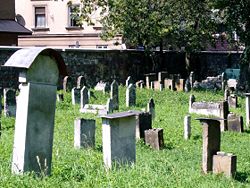
Remuh Cemetery
Encyclopedia

21.jpg)
The Remuh Cemetery, also known as the old Jewish cemetery of Kraków (Cracow), in Kraków
Kraków
Kraków also Krakow, or Cracow , is the second largest and one of the oldest cities in Poland. Situated on the Vistula River in the Lesser Poland region, the city dates back to the 7th century. Kraków has traditionally been one of the leading centres of Polish academic, cultural, and artistic life...
, Poland
Poland
Poland , officially the Republic of Poland , is a country in Central Europe bordered by Germany to the west; the Czech Republic and Slovakia to the south; Ukraine, Belarus and Lithuania to the east; and the Baltic Sea and Kaliningrad Oblast, a Russian exclave, to the north...
, is a Jewish cemetery established in 1535. It is located beside the Remuh Synagogue
Remuh Synagogue
The Remuh Synagogue, , is named after Rabbi Moses Isserles c.1525-1572, known by the Hebrew acronym ReMA, רמ״א, who's famed for writing a collection of commentaries and additions that complement Rabbi Yosef Karo's Shulchan Aruch, with Ashkenazi traditions and customs. Remuh Synagogue is the...
at 40 Szeroka Street in the historic Kazimierz
Kazimierz
Kazimierz is a historical district of Kraków , best known for being home to a Jewish community from the 14th century until the Second World War.-Early history:...
district of Kraków
Kraków
Kraków also Krakow, or Cracow , is the second largest and one of the oldest cities in Poland. Situated on the Vistula River in the Lesser Poland region, the city dates back to the 7th century. Kraków has traditionally been one of the leading centres of Polish academic, cultural, and artistic life...
.
Rabbi Moses Isserles
Moses Isserles
Moses Isserles, also spelled Moshe Isserlis, , was an eminent Ashkenazic rabbi, talmudist, and posek, renowned for his fundamental work of Halakha , entitled ha-Mapah , an inline commentary on the Shulkhan Aruch...
(ca 1525-1572) is buried there along with his family. Other notable burials include Mordechaj Saba, also called Singer, head of the Kraków Talmudic Academy from 1572-1576; Joseph Kac, head of the same academy in 1576-1591; Nathan Nata Spira
Nathan Nata Spira
Nathan Nata HaKohen Spira was a Polish rabbi and kabbalist. He had an important role in spreading Isaac Luria's teachings throughout Poland. Spira was the author of the Megaleh Amukot.Spira was a student of Meir Lublin....
(1583-1633), Kraków rabbi and head of the Academy from 1617-1633; Jozue ben Joseph (1590-1648), also head of the Academy; Joel Sirkes (Bach, 1561-1640), rabbi of the Kraków Jewish community and head of the Academy; Gerszon Saul Jom Tow Lipman Heller (1579-1654), rabbi of the Jewish communities in Vienna
Vienna
Vienna is the capital and largest city of the Republic of Austria and one of the nine states of Austria. Vienna is Austria's primary city, with a population of about 1.723 million , and is by far the largest city in Austria, as well as its cultural, economic, and political centre...
, in Prague
Prague
Prague is the capital and largest city of the Czech Republic. Situated in the north-west of the country on the Vltava river, the city is home to about 1.3 million people, while its metropolitan area is estimated to have a population of over 2.3 million...
and of the community in Kraków from 1643-1654, a rector
Rector
The word rector has a number of different meanings; it is widely used to refer to an academic, religious or political administrator...
of the Kraków Talmudic Academy from 1648-1654; Isaac Landau Lewita, rabbi of the Kraków's Jewish community from 1754-1768; Isaac Halewi, Kraków's rabbi and head of the Talmudic Academy from (1776-1799).
In 1800 the cemetery was closed and a nearby New Jewish Cemetery in Kraków at 55 Miodowa Street was built. Izaak Jakubowicz, donor of the Izaak Synagogue
Izaak Synagogue
The Izaak Synagogue or Isaac Synagogue, formally known as the Isaak Jakubowicz Synagogue, is a Prayerhouse built in 1644 in the historic Kazimierz District of Kraków, Poland. The synagogue is named for its donor, Izaak Jakubowicz , also called Isaac the Rich, a banker to King Władysław IV...
is buried there.
During the German occupation of Poland, Nazis destroyed the cemetery, tearing down the walls and selling the tombstones for use as paving stones. The tombstone of the Ramah is one of the few that remained intact. The cemetery has undergone a series of post-War restorations. As is common in contemporary Poland, tombstones found in use as paving stones have been returned and re-erected, although they represent a small fraction of the monuments that once stood in the cemetery.

